by Sam Tackeff | Dec 16, 2017 | Ingredients, Meal Planning, Quick and Easy, Shopping
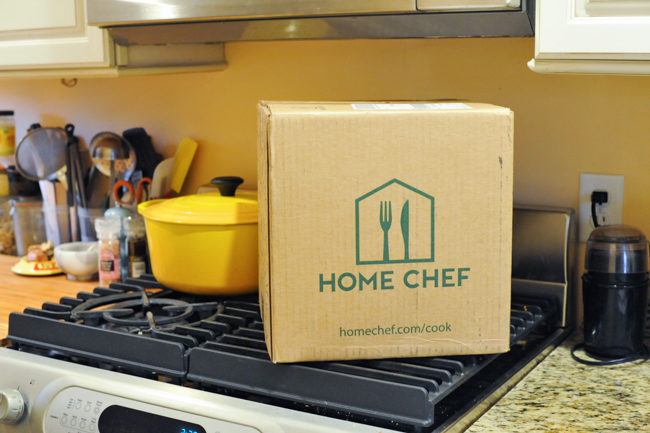
Well hello there! What’s cooking? I’m back in the kitchen today with a quick profile of another meal kit delivery service for your reading pleasure.
This installment? I try it: a week of “Home Chef”.
A few years back I took on a new kitchen challenge: to cook, taste, and review a variety of meal kits. In a sea of meal kits, I wanted to answer the age old question of: which meal kit is the best on the market right now?
Among the initial entrants, I tried Sakara (not actually a kit – it’s really $$$ organic meal delivery), Purple Carrot (vegetarian), and then many months of Blue Apron which I was then too lazy to cancel. On the plus side, it was good for a more comprehensive review, which you can read here.
At the end of the day, I found that cooking meal kit takes me a lot more effort than doing my own meal planning, shopping, and cooking. It’s also a good amount of waste packaging wise. And truthfully, I’m a better and more creative cook.
Nevertheless, I’m still charmed by the appeal of having a box of goodies show up on my doorstep and someone occasionally taking over the mealtime decision making, so I’m continuing my mini quest and trying different boxes every so often in order to share with you all, dear readers.
Disclosure: Home Chef knows nothing about me, but I did get a free box through their refer a friend program, and the links to Home Chef are affiliate links which give you $30 off your kit, and give me more free food. (If you order enough kits, you can send a free box to a friend; on par with most of the other meal kit customer acquisition programs.)
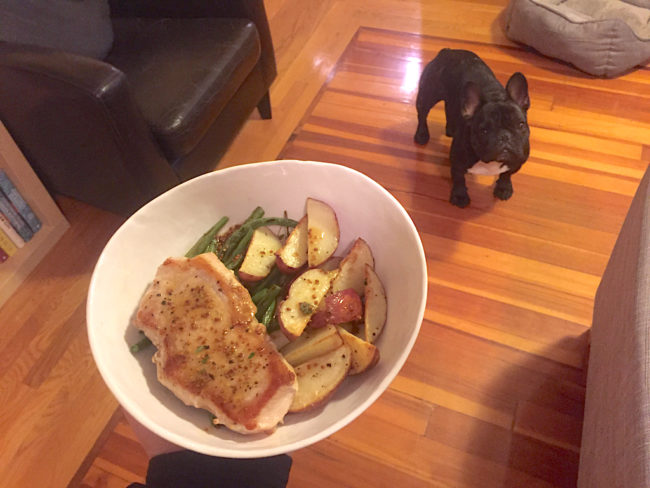
The details:
Home Chef Box overview – Home Chef is a more general meal kit without any particular slant. I’d characterize them as American home cooking with a hint of global food exploration but nothing overly fussy or too adventurous for the average palate. The company is based in Chicago, and has raised 57 million through series b (see Crunchbase), which is about a quarter of the funding of Blue Apron who was just shy of 200 million pre IPO and less compared to HelloFresh’s 365 million pre IPO.
How much does Home Chef cost?
This is a little complicated: $9.95 per serving – two servings of two dishes in the box; although you can add on lunches (most are $7.99/serving), seasonal fruit ($4.95/serving), or a smoothie ($4.95/serving) as extra which is a nice touch. If you glance, it’s not totally clear that the add ons will charge you for two servings. You can also choose some weeks from “Premium Meals” which seem to include bigger pieces of steak or lamb for 19.95 a serving, but these aren’t offered every week. And if your order is under a certain amount, you get charged the $10 for shipping. So the minimum box comes in at around $49.80 and goes up from there.
What kind of meat and produce does Home Chef have?
Generally, I found Home Chef’s to have an overall decent quality of produce and meat, although, notably NOT organic. (Most of my personal purchasing is organic and I get my vegetables and meat from a farm share; so I don’t think I’d get the box regularly for this reason alone.) Nothing seemed wilted or bruised, and generally everything was tasty. The fresh sausage packed in the lasagna skillet likely wouldn’t have past the two days I waited to cook it though even though it suggests that it would last 6 days on the recipe card.
The service strikes me as less “foodie” focused compared to, say, Blue Apron’s inserts about the farms and farmers (which sometimes strikes me as greenwashing but I still buy into), although does suggest wine pairings.
What kind of recipes does Home Chef have?
The recipes and ingredients on Home Chef are notably a little bit more basic than other services. I ended up going with two fairly simple dishes which worked well, although I’d be curious as to how the flavors are on the more global recipes. Each week you get to choose from several options on the list.
For my box, I chose the grilled pork chop with whole grain dijon sauce, and the Italian sausage lasagna skillet.
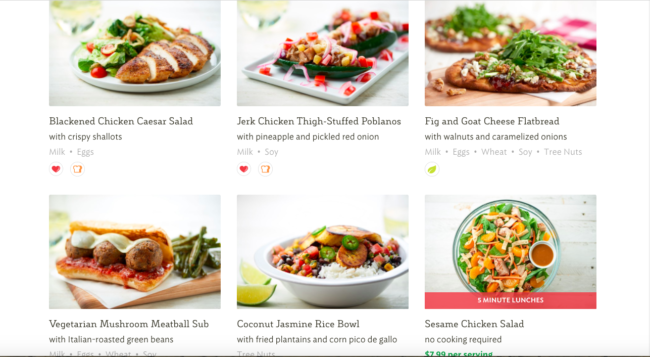
How easy are the Home Chef recipes to follow?
As you can see in the picture of the sheet; the recipes are fairly simple and bulleted. You are encouraged to read through the whole recipe before starting (which is good practice, but always a useful reminder). I found that the recipes might leave a little too much room for interpretation for a novice cook, but I got along just fine. There were a few steps in each recipe that weren’t what I’d have written, but in the end, my dishes turned out alright. For example: the skillet called for “one medium oven-safe pan” although the picture seemed to be of a cast iron, I wasn’t sure what actual size cast iron counts as “medium” (8 inch? 10 inch?), so opted for a pyrex.
Decently quick to cook. Unlike other meal kits, the Home Chef recipes seemed to take less steps and take me less time overall to cook. Each dish was closer to 25-30 minutes of cooking (compared to Blue Apron which routinely had me chopping, prepping, etc. for 45-60 minutes.) Home Chef was closer to the promise of ease than other kits that I’ve tried so far.
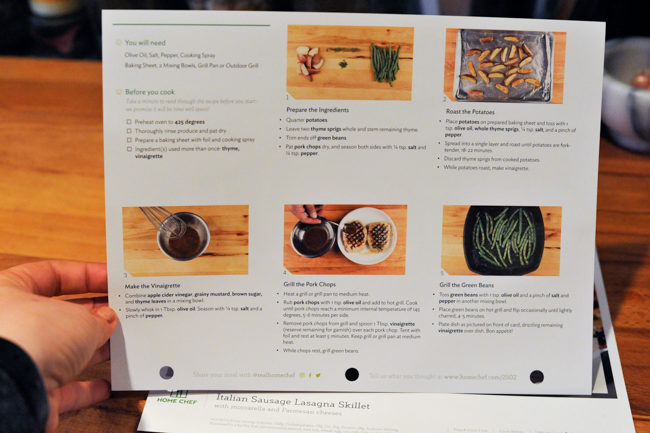
In your first delivery, Home Chef sends you a little plastic binder to save your recipe cards. It’s a little flimsy, but was a nice touch.
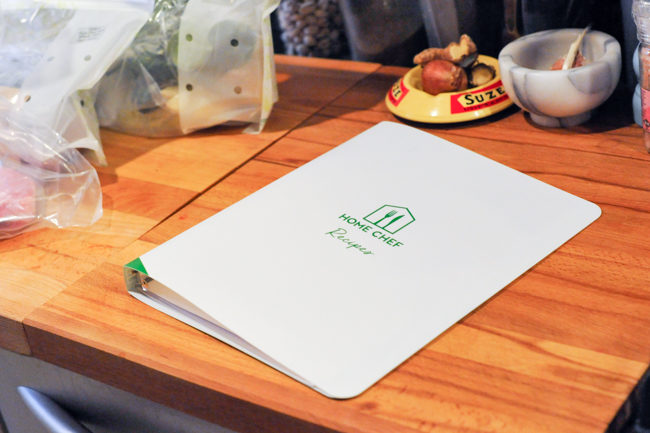
What’s in the Home Chef Box?
Aside from the recipe cards, the box itself is filled with individual bags – one for the combined meats, and then individually packaged bags for the separate meals themselves which include all produce, spices, etc.
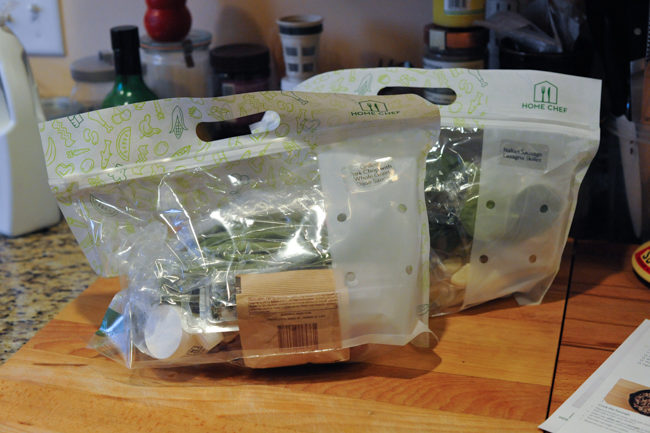
* Packaging – I’m not sure that anyone will solve this – it’s about the same size box as Blue Apron; each meal comes in it’s own little plastic bag, and the meats are separated into bags, the box here is filled with an icepack, and a soft plastic material filled with batting of some type. Still a PITA to break down and recycle, but what can you do?
I’ll note here that my Frenchie Bertram is not afraid of much in life, with the clear exception of cardboard boxes from meal kit delivery services. Which he wanted to let me know was NOT OKAY for me to put on “his gel mat bed” in front of the stove while I took this photo. If I could have added the audio file from his complaints here, I would have.
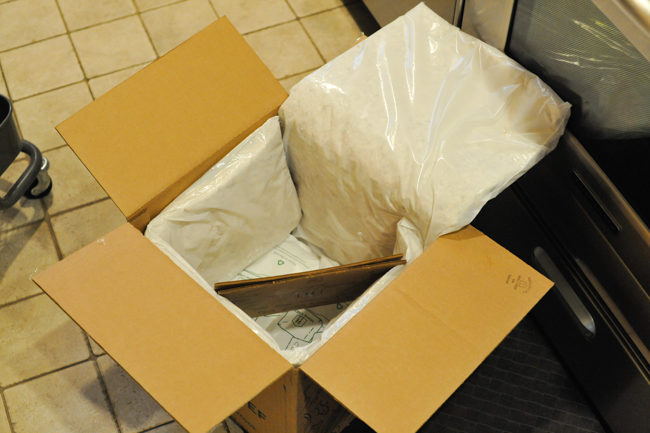
How much food is in each Home Chef box? Is Home Chef healthy?
Portion Sizes – appropriate for two light-moderate eaters. I was still hungry after both dishes. I tend to supplement meal kits anyway with more vegetables, but volume alone wouldn’t have been enough for me to be satisfied, even though calorically the dishes were in the 500-700 calorie range. I’d love to see more vegetables to round out the dish.
Nutrition: the recipes themselves do have ingredients and high level macros listed (calories, carbs, fat, protein and sodium) for those interested in tracking. You can choose from a variety of different diet preferences, including vegetarian, low carb, and calorie conscious meals.
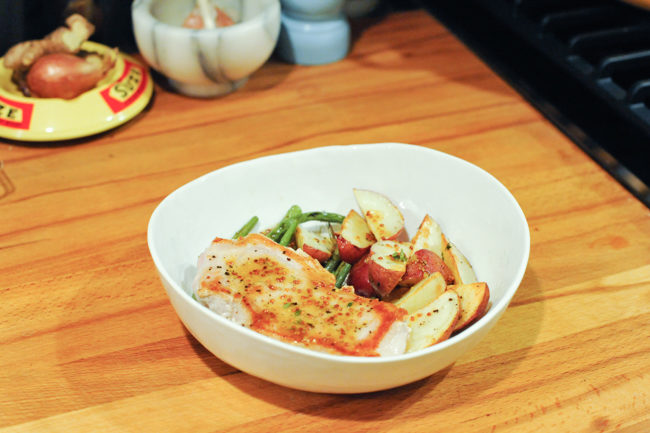
Other notes: I had to email customer service to move my first deliver date (before cut-off) because I ended up having a last minute travel situation. They were quick, competent, and pleasant to deal with.
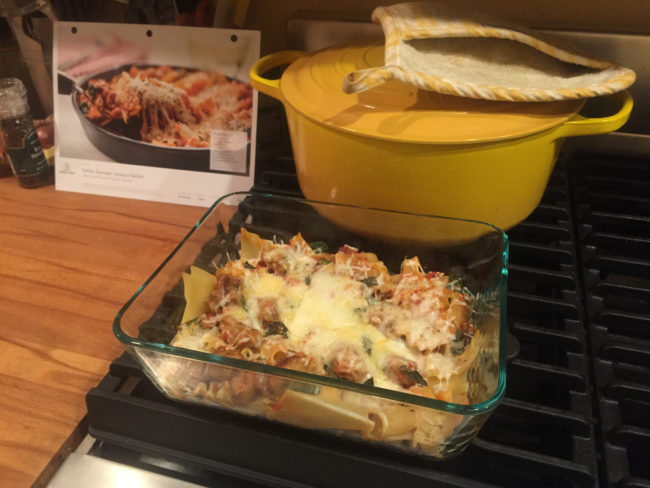
The Bottom Line:
Did we enjoy the Home Chef meals? Yes. Both meals tasted good. The pork dish was slightly better looking in presentation, but flavors were very good with both. As mentioned above, would have liked a little bit more vegetable for volume! I think overall I prefer a slightly more spiced and creative dinner if ordering a meal kit, but Home Chef does deliver on overall taste if you don’t mind a slightly boring meal.
Would we order Home Chef again? Possibly. I haven’t actually canceled the service, so it’s quite likely that I might try another box to compare and update this review.
Want to read more meal kit reviews? Here’s my comprehensive review of several months worth of Blue Apron meals, and I’ll be updating this post as I try more kits.
by Sam Tackeff | Nov 26, 2014 | Baking, Condiments, Ingredients, Quick and Easy
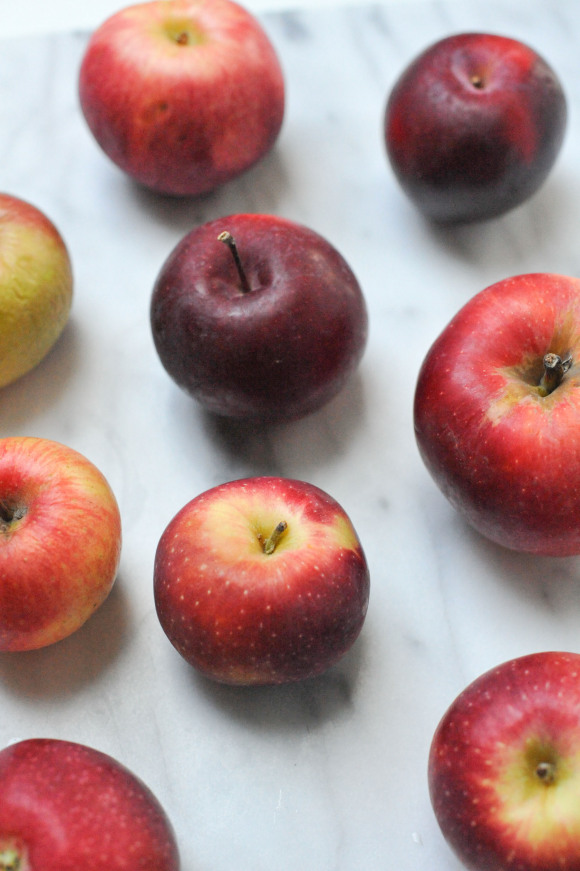
I started preparing for winter this week. A puffy vest for was acquired, which I will now live in, and a new coat – an extra layer that I know I’ll be needing. Somehow, I’m never fully prepared for the weather.
I’ve been trying to make my way through several books that need to be finished before I can read new ones – Thrive by Ariana Huffington, I Am Malala, and a handful of others. I started Jo Nesbø’s The Bat but it wasn’t what I expected it to be. Fortunately it’s short, so I’m powering my way through it.

These leaves are now covered by a good layer of ice and sludge that have been accumulating today – what a difference a few days can make. I’m trying to prepare myself for a world of ice and salt and knocking the snow off of my car.



The leaves were stunning this week. Hanging on. Visually, this is my favorite time of year. Emotionally, it’s a little bit of a roller coaster – bracing myself for the long cold winter. I’ve been trying to do a little more to prepare this year: getting someone to help us with a deep cleaning of the house, acquiring new heaters so that we don’t freeze when our old steam heat fails us. A few months ago I won a new blanket, massage gift certificate, and a light alarm from the Tart Cherry Marketing board, and they’ve been particularly useful this week! (Always enter contests if you like the prizes!)



Somehow there is new growth.


And apples. Which of course I use to make applesauce when I can. It’s such a comforting food.
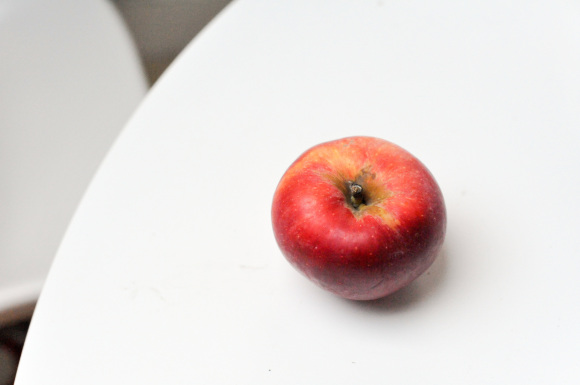
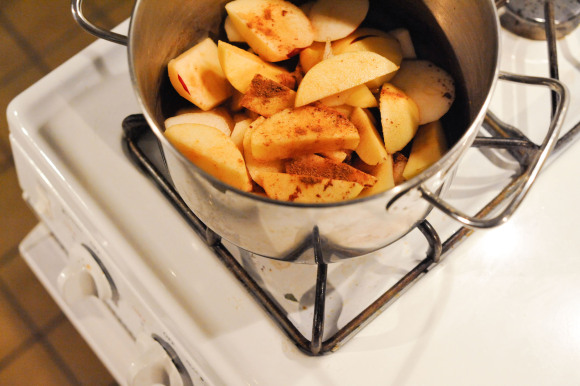

Applesauce, many thoughts.
Applesauce. It’s one of those things that takes no time at all – a half hour maybe? Makes your house immediately smell like the holidays, and provides you with comforting sustenance. It’s the most beautifully simple thing to make. You really only need apples and a little water, and you can make something perfectly good.
When I set about making applesauce, I usually make a small batch – 5 or 6 apples. You can make a huge batch, but I like to cook in a small pot, and change up my spice mixes. This allows you to make this recipe many times in order to try out what you like and what you don’t.
I like to use a blend of apples. I like my apples on the tart side. My favorite as a child was always the McIntosh. This batch had a few Empire apples, a few Macoun.
I take apples, and I peel them. I cut out the cores, and slice them. Sometimes I leave a little peel here and there, you don’t need to be perfect. You also don’t need to peel them. If you leave the peels on, your applesauce will become rosy.
You’ll want an acidic component – this can help the apples from browning, and also will provide the flavor with some snap. I’ll sprinkle my apples with the juice of a lemon. (But I don’t always remember, and it turns out okay without, too.)
In a heavy bottomed pot (you don’t want anything to burn), put your sliced apples. If you want a sweeter applesauce, you can put in some brown sugar, maple syrup, maple sugar. Just a few spoonfuls, don’t go overboard. If you are adding sweetener, I also like to add a pinch of salt.
Here I’ll choose my spices – if you don’t have many choices, go for cinnamon. You can put a little – maybe a teaspoon, to a few tablespoons, for a deeply spiced sauce. Sometimes I do a tablespoon of pumpkin pie spice. Chai spices are good, too.
You’ll want a liquid to get things started. A cup or so of cider, apple juice, or water. You could also do wine! For this batch I did 3/4 cup of water, and about a quarter cup of honey mead!
Cook the apple liquid over medium heat, covered, making sure to stir every so often to let the apples soften. You can let it cook for longer, but make sure to turn the heat down to low. When I’m in a hurry, I’ll cook it for 30 minutes.
When the apples are cooked through and tender, mash with a fork for a chunky texture, or purée with an immersion blender for that smoother sauce.
Eat it warm, or cold. Store in the fridge, or in the freezer to preserve the bounty for longer. (Of course you can put it up, too, but I like doing that with a larger batch.)
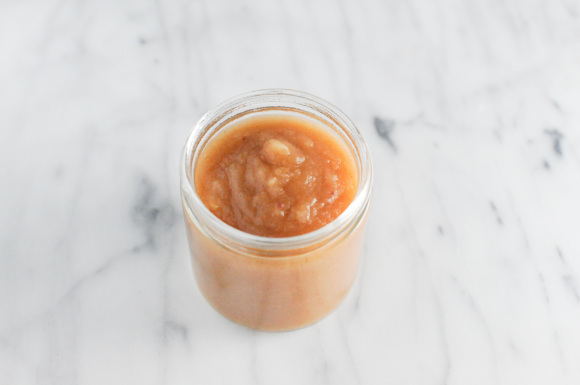
Applesauce (the short recipe)
3 pounds assorted apples, peeled, cored, and slice
1/2 cup of liquid: apple juice, apple cider, water, or a combination
1/4 cup honey mead (totally optional)
2-3 tablespoons maple syrup (or brown sugar)
2-3 teaspoons mixed spices (cinnamon, allspice, pumpkin pie spice, nutmeg)
Combine all the ingredients in a heavy bottomed bot, and cook on medium heat, covered, stirring every so often for 30 – 60 minutes until apples are soft. Mash with a fork, or puree with an immersion blender.
by Sam Tackeff | Nov 21, 2014 | Ingredients, Local stores
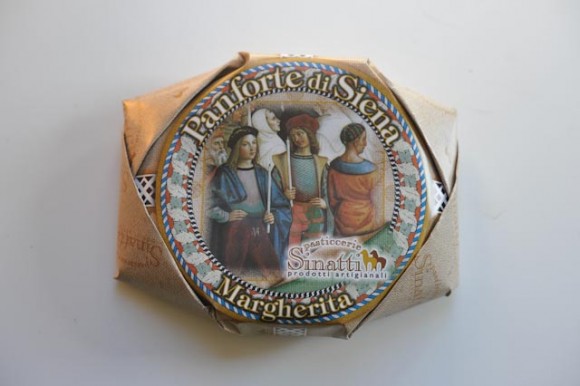
Now that you’re hopefully gorging yourselves on Kringle, here’s another holiday treat worth going out on a hunt for – Panforte. I noticed that there were a stack of these when I stopped by Formaggio Kitchen this morning, but these are photos are from the one I ate last year (before I learned how to focus my lens, apparently,) and I’ll be picking up a new one in the next few days. The Panforte is similar to a fruitcake – a dense round of candied fruit and nuts that is heavily aromatic with warming spices.
I have a history of hiding food that is just too good to share – my mom and I famously rationed a jar of crunchy Biscoff spread for months by hiding it in the lid of our couscoussière and eating it by the single spoonful – and this is one of those foods that you consider hoarding to yourself and not sharing with anyone. It’s worth sharing however, because even selfishly, you’ll make friends with this treat.
The Panforte di Siena from Formaggio comes with it’s own little powdered sugar packet. If you can’t find a round of this, you can make your own: I’ve had this recipe from David Lebovitz bookmarked for the past two years.
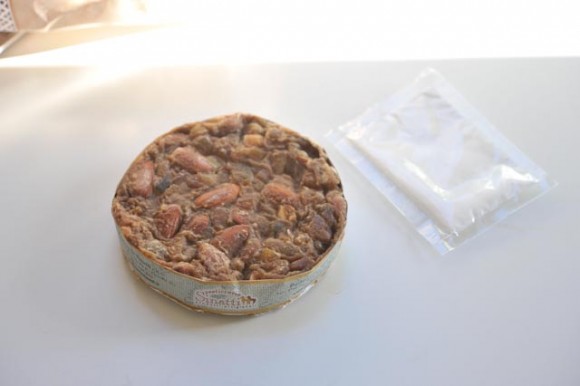
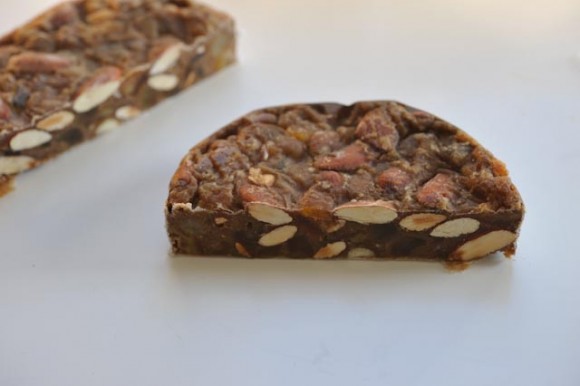
I’d say that this is too rich to eat more than a little slice at a time, but I’d be lying – it’s rich, certainly, but left to my own devices I could polish this thing off over the course of a long afternoon.
Other similar seasonal treats I’d like to try making:
Melissa Clark’s Moist and Boozy Fruit Cake
Laurie Colwin’s West Indian Black Cake
Do you have any favorite holiday spiced cakes?
by Sam Tackeff | May 4, 2014 | Ingredients, Turkish, Vegetables
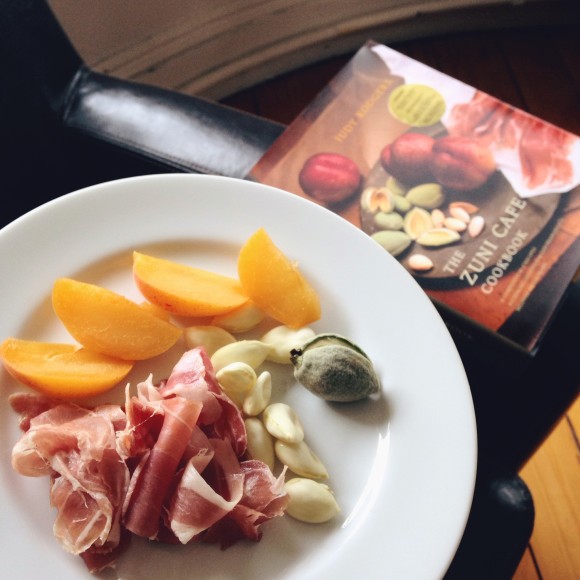
Yesterday at Formaggio Kitchen I noticed a basket full of green almonds, but passed them over while gorging myself on cheese samples because the $6/pound price tag made me cringe. Yes, they’re shipped from California, but boy is that a markup – in California you might see them for a few dollars a pound. Today I went back, with clearer perspective, to pick up a small bag for snack – some seasonal items with short windows are worth paying a premium for just in case you can’t find them somewhere else for cheaper before they’re gone.
Green almonds are tart fuzzy pods that contain almonds in their earliest stage of maturity– a springtime treat that you can often find in Middle Eastern markets. You can eat the pods whole doused with a little olive oil and salt, or you cut them open with a little paring knife down their center groove and eat the white almonds that haven’t yet hardened. The pods are crunchy, and filled with a clear citrusy jelly substance. Unlike the mature nut, they are soft, fresh and verdant – more plant-like than nutty in taste. In the Middle East, they are often pickled, sometimes fried, and sometimes featured in stews, such as the Persian Khorest-eh Chagaleh Badam, with beef, parsley, and mint. Usually, they are just eaten plain, accompanied by a cold beer, but also taste delicious sliced into spring salads.
Today I took a cue from the masterful Judy Rodgers in her Zuni Cafe Cookbook, and stole the pairing right off the cover photo: green almonds, stone fruit and prosciutto. If you happen to see these cheerful orbs, grab them quickly, before they are gone.
by Sam Tackeff | Nov 6, 2013 | Condiments, Eggs, Ingredients, Uncategorized
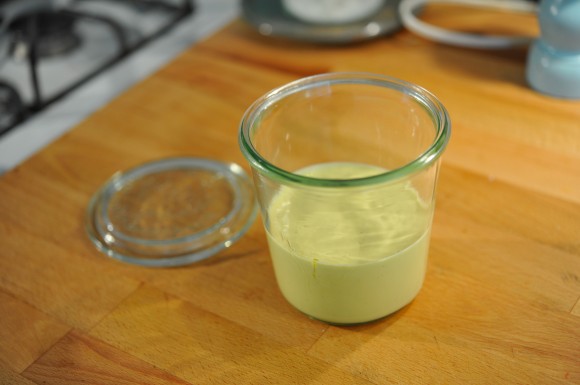
A friend in the gym today mentioned that her mayonnaise was breaking, and I felt for her. Truly, there’s nothing like a sauce that refuses to do what you want it to – which is almost always emulsify. I suspected that the Vitamix was the culprit here, so I mentioned my tried and true mayonnaise tool: the whir-whir! (That’s how I refer to my immersion blender. I’m fun like that.)
Here’s my usual recipe. It’s based on a dozen or more ideas for mayo that I’ve read here and there: Alice Waters, Tamar Adler, even J.Kenji Lopez-Alt, Patience Grey… everyone has a basic recipe. It’s a little un-traditional with that whole egg (read: lazy.)
Mayonnaise: It’s Easier Than You Think
When you go to your fridge and you are out of Mayonnaise, fret not. Take the little cup that comes with the immersion blender. Into it, crack a whole egg, preferably very fresh and from a reputable source, and at room temperature (having the oil and the egg at the same temperature helps promote emulsion). You aren’t cooking the egg, and a farm egg tastes so much better. Add a large spoonful of Dijon, a teaspoonful of vinegar, and lemon juice – about a half lemon’s worth. I always like Sherry vinegar, but you could use cider vinegar here, or rice wine vinegar, or maybe red wine vinegar. You could be minimal here – just the mustard and lemon juice, but I like the mix of acidity. And then you pour in your oil – between 3/4 and a cup. I try to use a fairly neutral oil. You could use half olive oil if you’d like, but full olive oil tastes incredibly olive-y and limits what you can actually do with this stuff. Here is the fun part. Stick the immersion blender in and whirr. Within about 20 seconds your mayo will come together. Usually I have to stir a little bit to get it going, but I’ll just blitz until I get to a good consistency, which for me, is slightly less firm than the store-bought stuff.
Optional twists: you could add a few cloves of finely minced or crushed garlic in here and it becomes an “aioli” of sorts. Or, you could add a handful of fresh herbs, or any variety of spice to taste.
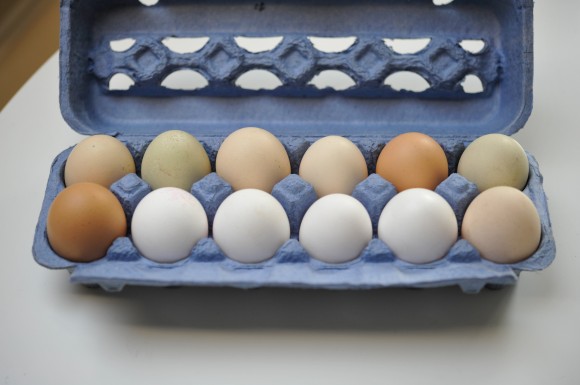

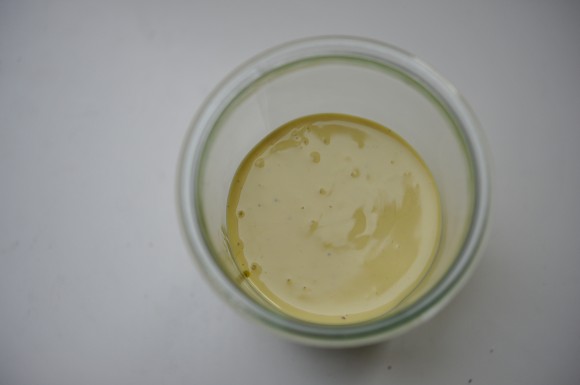
Now that you have this stuff on your hands, here are some ideas of what to do with it:
1. Slather it on sandwiches.
2. Put a little dollop on top of eggs.
3. Serve with boiled or braised meats.
4. Place a generous spoonful on a bowl of cooked vegetables.
5. Make a raw vegetable salad with it. I like this recipe for “Coronation Cauliflower“, a raw cauliflower salad.
6. Make some home made coleslaw.
7. Slather it on grilled chicken.
8. Make seafood salad with crab, avocado, and a squeeze of lemon.
Or eat with a spoon, by itself, every time you open the fridge. Don’t be ashamed.
by Sam Tackeff | Jan 24, 2010 | Ingredients, Pantry Staples
This week, the food gods aligned yet again: Food Fete, the Winter Fancy Food Show 2010, and a last minute trip to the East Coast coincided all at once! It’s safe to say that I’m feeling stuffed and looking forward to a week of leafy greens and light broths to get back to feeling normal!
The week started off with Food Fete, a media event featuring new and delicious products to sample. Some of my favorites included the blue cheese stuffed figs from the California Fig Advisory Board, the frozen quinoa from Village Harvest and Sweetwater Spice Co.‘s fajita bath, an incredible meat marinade. But I will say that the hugest surprise were the various sausages and products from the Field Roast Grain Meat company, which, being a vegan meatless product made of grains (alas, not gluten free) were perhaps the tastiest meatless products I have ever eaten. I was honestly shocked!
After a lovely evening, I went home to prime my stomach for day two, a full day at the Winter Fancy Food Show. The Fancy Food Show is the ultimate food discovery event – over 1300 vendors show up to share their products. Even pacing myself, I’d say that I may have had about 75-100 samples over the course of the day, but these were some of my favorites:
Happy Goat – Goat Milk Caramels. A smash hit. These caramels are made in tiny batches in the Bay Area, out of goat milk, organic sugar, and vanilla. Pop one in your mouth and you experience what I like to refer to as “SQUEE!!!!” : becoming completely unable to focus on anything other than how wonderful these are. And if say, you happen to have a morning caffeine habit, these taste absolutely delicious when stirred into coffee.
Cowgirl, Bellwether Farms, and Cyprus Grove Cheeses: it’s safe to say that these bay area favorites are some of the best cheeses around. I was excited to try Cowgirl’s new Devil’s Gulch cheese, which is only available for the next few months (it’s in a test phase). Bellwether’s sheep milk ricotta is always delightful, and Cyprus Grove’s Humboldt Fog is one of my favorites.
Secret Stash Salt: Having good salt is an invaluable part of any kitchen. I’m a big fan of Maldon Sea Salt, various coarse sea salts, but was completely wowed by the incredible flavors of Secret Stash – particularly the lavender, and the truffle salts.
Sam Adams Utopias: I’ve been trying to get a taste of Utopias for years, and was overjoyed to get my sip after asking coyly if they were still sampling it (there were no bottles left when I got there) – but the kind rep pulled out an unopened one and poured it for me! This stuff is touted as the strongest beer (at 27% alcohol), but tastes more like a fine liquor than a beer. In the future, when I can throw around mass sums of cash without worry, I’ll keep this in stock in my liquor cabinet. Smooth, potent, and delicious.
Black Garlic (see photo at top) – Black garlic, a fermented garlic product which tastes sweet is delicious! The fermentation process adds extra health benefits, and mellows the garlic flavor, producing a sweet product, almost like dried fruit. I’m thinking spread on some warm toast, this would be delicious.
Fentiman’s Shandy – Fentiman’s brand of fermented natural sodas are truly spectacular. They have them at Il Cane Rosso in the Ferry Building in San Francisco, but come originally from the UK. I was psyched to finally try the Shandy – a beer and lemony soda mix which is refreshing and delicious.
Kodiak Cakes – After seeing Jenna from Eat, Live, Run feature these regularly on her blog, I was excited to try some of their pancakes. Normally I’m a “from scratch” type of gal, but this mix is going to become a regular staple in my household – and I’m looking forward to trying more of their products. As I’m also particularly interested in the business of entrepreneurial food companies, Joel from Kodiak was really kind to give me a copy of the ‘History of Kodiak Cakes’ which I’ve been making my way through.
Barney Butter – I stir nut butter into my oatmeal, on toast, and even into savory soba noodle salad. Recently I switched from peanut butter to almond butter, which is slightly more nutritious and in my opinion more filling. Barney Butter is a brand of almond butter which I find particularly tasty, and was happy to see that they were at the show, and sporting a cute new look.
Stonehouse 27 Spice Co: While I’m most likely to make my own cooking sauces when creating Indian dishes, I was completely impressed by these flavorful sauces created by a sweetheart entrepreneur named Sharon Fernandes. The sauces are salt-free and bursting with flavor. I tried as many as I could, my favorite being the cashew cream. These are definitely going to be in my cabinet.
Nutmeric – Turmeric is a staple in my kitchen, and I was excited to see this nut butter product with turmeric at the show – nutmeric was developed by a chemistry professor, which touches at my heartstrings, and made me chuckle. There is a huge* crossover between science people and food people…(I heart all my former science profs!)
Other favorites included Kikkoman’s new yuzu ponzu sauce, yuzu being a delicate citrus, which they served with tempura shrimp and avocado. I’m looking forward to seeing this product on the market. Yuzu also showed up with Yuzusco – a liquid spice… And I also quite enjoyed my Hudson Valley Foie Gras, the savory macarons by Fabrique Delices, and some delicious Nueske’s bacon.
Finally, I was happy to see some hometown favorites from New England, including Stonewall Kitchen, Lollipop Tree, Stoneyfield Oikos yogurt to name a few.
































